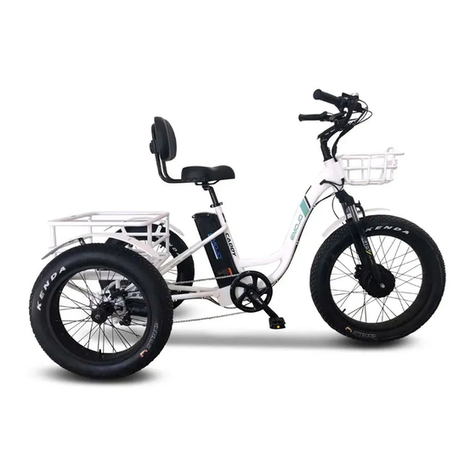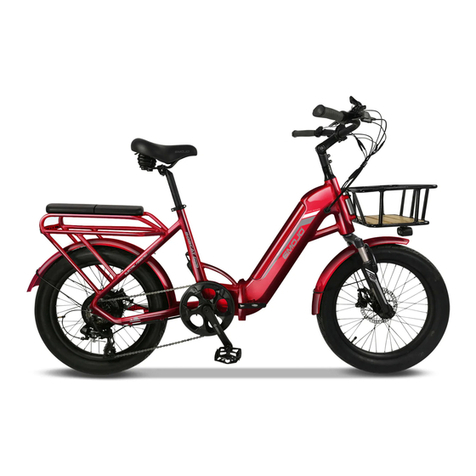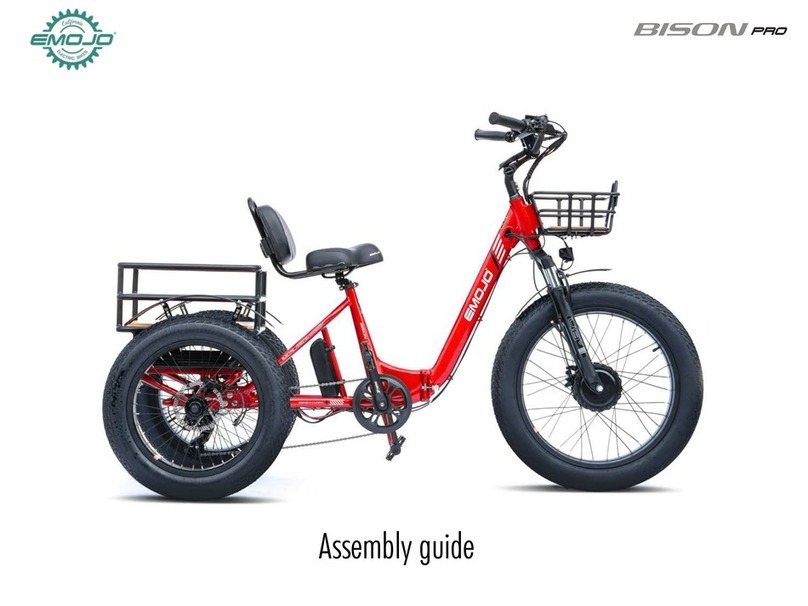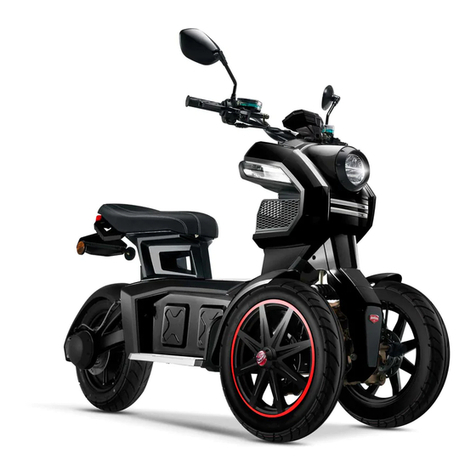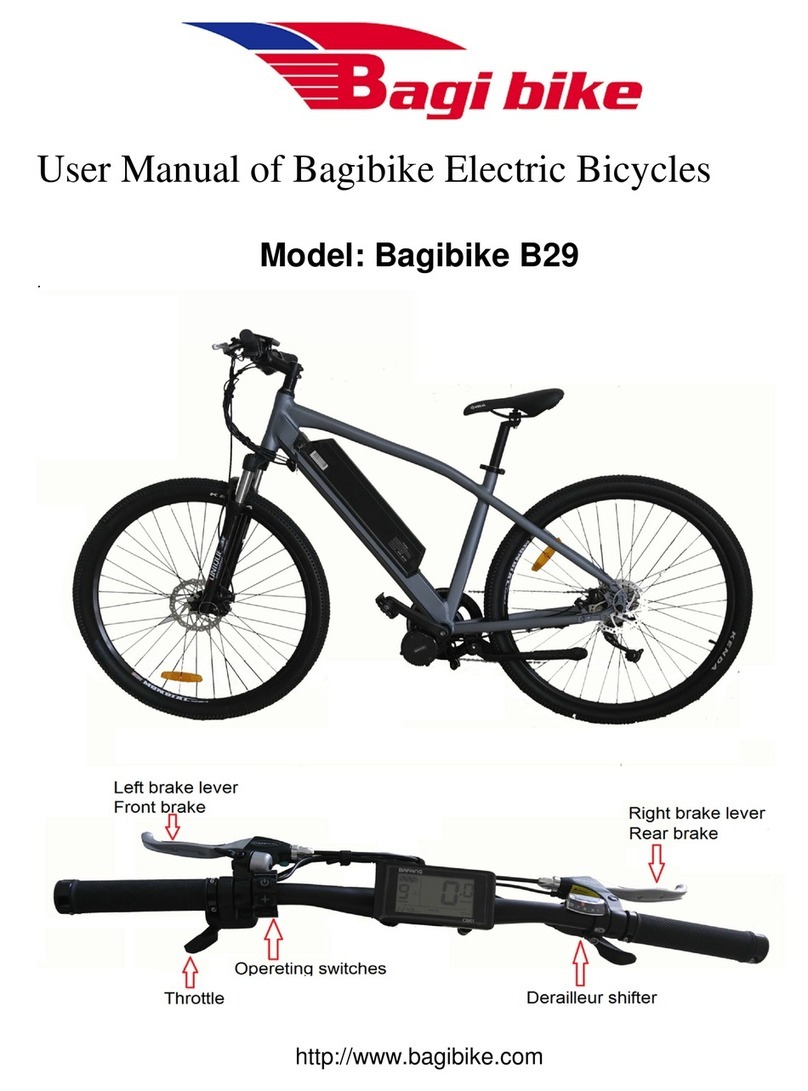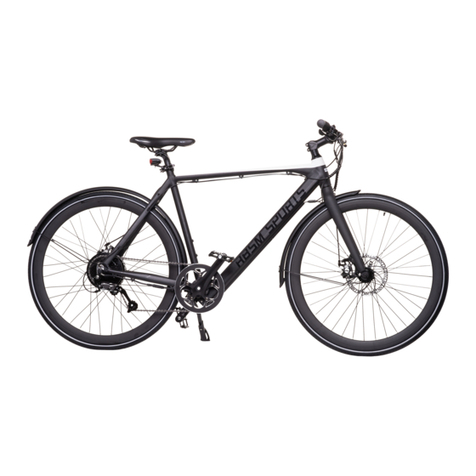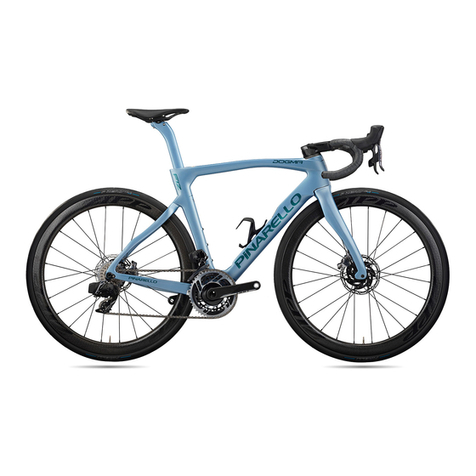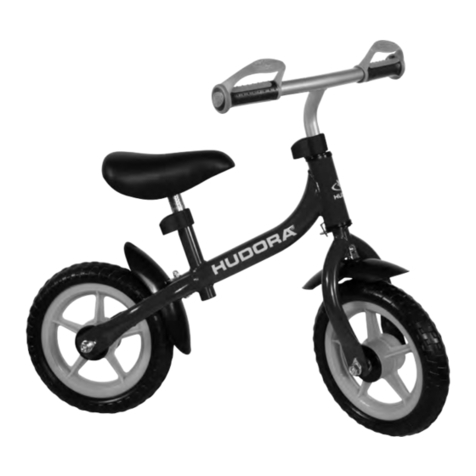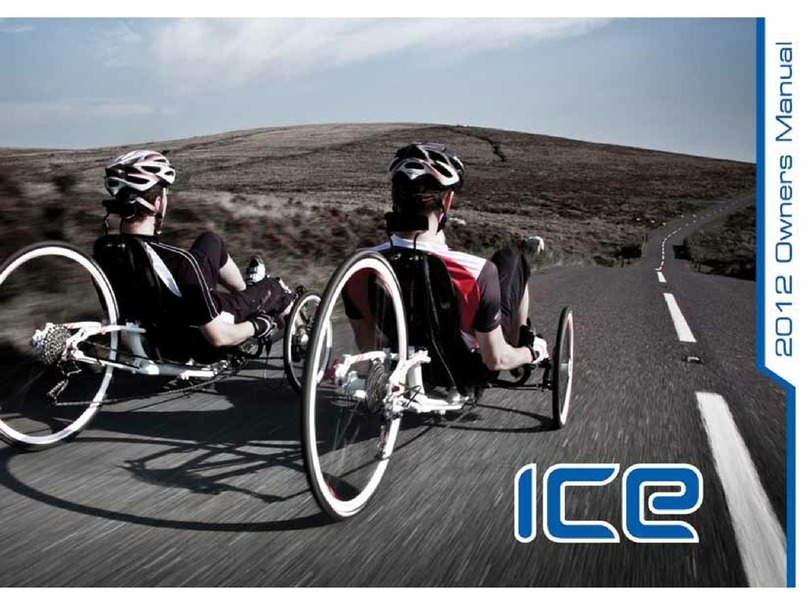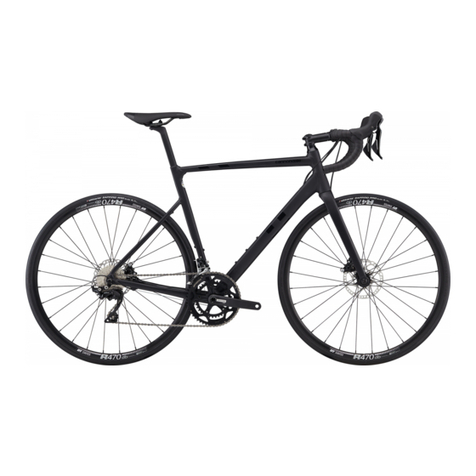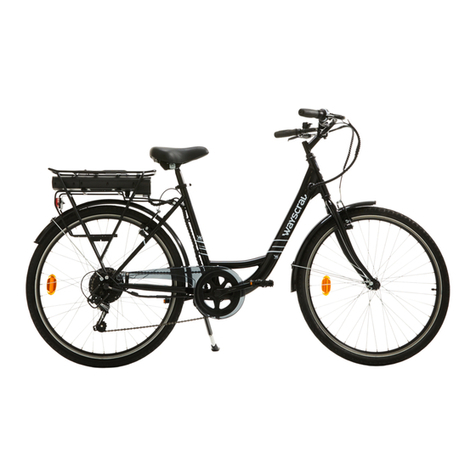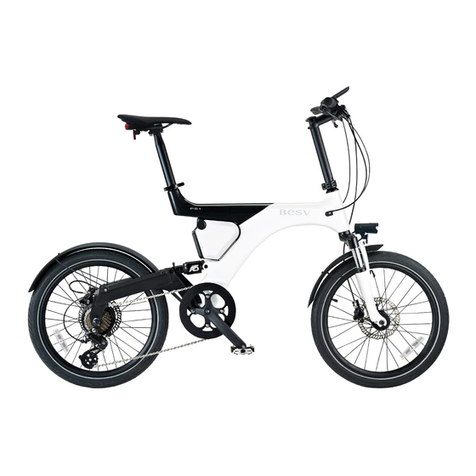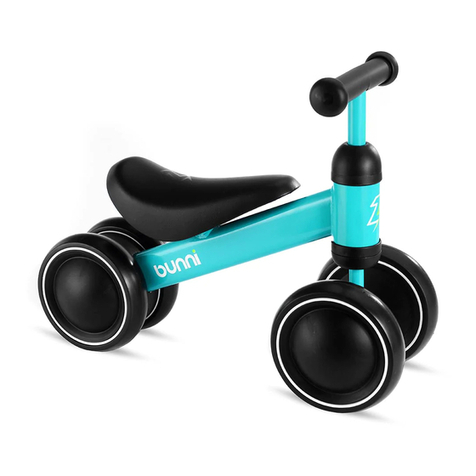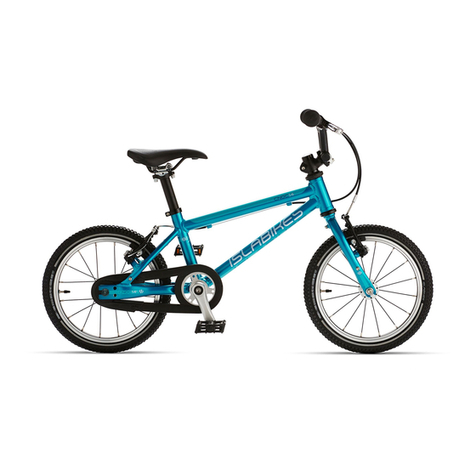EMOJO LYNX PRO 750 User manual

OWNER’S MANUAL

Instructions
Warnings
Explanatory drawing of the overall bike configuration
Schematic diagram of the electric bicycle
Main technical parameters
Throttle control and gears
Operation stages
P.A.S. Control
Charging your battery
Battery mounting and removal
Front wheel installation and seat adjustment
Brakes
Pedas and tire adjustment
Chain
Commoun faults and maintenance
Troubleshooting
FAQ
Contact us
1
2
3
4
5
6
7
11
12
13
14
15
16
17
18
19
20
9-10
CONTENTS

Instructions
1
1.
Please read the manual carefully before using your EMOJO electric bicy cle.
2.
Make sure all parts are locked tightly, such as the frame joint, handlebar, seat post and pedal, etc. before using. Do
not use electric bicycle before carefully reading the instructions and knowing about the performance of the electric bicycle.
Do not lend the electric bicycle to anyone who does not know how to operate it.
3.
Develop a habit of charging when the power of the battery pack shows a red light. Please charge and maintain the battery
pack consistently to have longer service; if the bicycle is not to be used for a long period, it is suggested to turn power of the
battery pack to the OFF position and charge-discharge the battery once per month.
4.
Frequent braking, starting, uphill, still starting, muddy and uneven ground, overloading of people and goods will assume larger
electricity, thus influencing the travel mileage. If you want to get the best travel mileage, we suggest you follow the following
instructions:
Ride the bicycle to a certain speed by pedaling prior to turning on pedal-assist or throttle power.
Try to decrease the frequency of braking and starting while maintaining safe riding habits.
Please assist with pedal when the slope angle is steep, or the wind speed is fast.
5.
When you lift the battery, please do not insert any metal objects (such as wires, keys, etc) into the charging socket or bridge the
negative and positive poles of the battery cell. This can cause battery short-circuit, resulting in a fire and putting your safety at risk.
6.
This e-bike is not intended to be ridden through water. When the water level inundates the controller, electrical circuitry or
motor hub, it is possible that it will cause short circuit and damage the circuit, please pay attention to avoid burning down the
electronic control system!
7.
The standard load weight of this bike is 230 lbs. (including the cyclist), overloading may cause the travel mileage to decrease,
or cause the spare parts of the bike damage and reduce working life of battery.
8.
Warranty will be void if a non-approved battery charger or other non-original EMOJO spare parts are used.
9.
M
inors,
p
regnant women or anyone that does not have
f
ull de
x
terity o
f
hands and legs should not use this product.
10.
P
lease check the tightening state o
f
f
ront a
x
le, bottom bracket shell, rear a
x
le, etc.
f
re
q
uently in use.
11.
C
hildren younger than
14
should not ride the electric bicycle.

2
Warnings
Please pay attention to the following items for your safety:
Battery warnings
Battery warnings
Disassembling and refitting the bicycle may bring hidden safety hazards
to your electric bike, therefore, causing risk.
Do not keep, approach or store the battery near high heat sources.
Avoid areas near flammable or explosive liquids or gas.
Do not tamper or disassemble the charger. Avoid violent dropping or
smashing it.
Charge your battery in a well ventilated area, free of humidity and far
from flammable or explosive objects.
While charging, there should be no foreign objects on the charger or
the battery shell.
Avoid contact betweent eh conductive objects and the battery poles
at the same time to avoid short-circuit and damaging the battery.
Always keep your hands dry while plugging and unplugging the power
plug and when handling the battery.
The battery is not a toy, keep children away.
Do not disassemble the battery case, do not attempt to make any
modifications or external conections. You will lose your warranty. Do not drop the battery, do not immerse in water and keep it away from
high-humidity areas.
Do not attempt to short-circuit the battery electrodes, which can
damage the battery, the bicycle controller and the charger.
Mak sure to check the set up and stability of the brakes, saddle, frame,
handlebar, wheels , etc. before riding to make sure all is in proper
working condition.
Avoid climbing sharp objects like stairs or rocks which can
damage the tires and wheels.
Do not attach any objects to the handlebar that may obstruct your
vision or handling.
This bicycle is for a single rider, not intended to carry any passengers.
Always wear a helmet.
Downhill speeding should be moderate, please do not apply the front
brake fully when slamming the brakes at high speed to avoid the front
wheel to lock and losing control.
The brakes should not be oiled to avoid causing iffy braking and
endangering your personal safety.
Wear the appropriate protecting apparel when riding under the rain.
Never use an umbrella and/or operate the bicycle with one handl.

Overall Bike Layout
Actual product may slightly differ from this picture
Pedals
Stem
Battery
Electric motor
Transmission chain 7-gear cassette
Seat post
Seat post quick
release lever
3
Quick connectors
Motor power
detachable
connector
Frame folding
mechanism lock
Serial number
Front disc brake
Rear disc brake
Controller
box
Rear rack Stem folding
mechanism lock

Diagram of the Electric Bicycle:
4
48V

Main Technical Parameters
Index
<55
230
Winter::::20
I
Summer::::25
Item
Total Weight lbs.
Load weight (including the Weight of Cyclist) lbs.
Travel Mileage on a single Charge Miles w/pedal
assist Power Consumption on a single Charge
(kilowatt) Power Consumption per Kilometer
(kilowatt) Type
Battery Voltage / Capacity
Motor Type
Motor Rated Output Power
Rated Voltage
Under-voltage
Protection
Controller
Charger
Over-current Protection Model
Duration of Charge
Main Appliance Input Voltage
Main Appliance Output voltage
Charging Current
<0.6
<1.2
Lithium Ion Battery
48v 10.4 Ah
Permanent Magnet DC Hi-Speed Motor 750W
48V
30.5V±0.5V/41.5 V±0.5V
15A±lA/17A±lA
48V 2A
Six to Eight Hours (Instant Charge two to four Hours)
AC110-220±10%50HZ
42±0.2V/54. 6±0.2V
2.0±0.2A
5

Hand Throttle Control
Your electric bike is equipped with a power and throttle control on the right
hand side. To power on your bike first make sure the switch to your battery
is in the ON position.
You control the throttle by pushing with your thumb the paddle, the farther
you push from its resting position, the more power is delivered to the motor
to accelerate. When you want to slow down, you simply release the throttle
and let it return to its resting position and simultaneously apply the brakes.
When the pedal assist mode is set to "0", the pedal assist and throttle function(s) do not engage. When the pedal assist mode is set to "
5
" the pedal
assist function does not engage and the throttle will accelerate the bike forward. The throttle control is operated on the right hand side. You control the
throttle by twisting it from its resting position. The farther the throttle switch is from its resting position, the more power is delivered to the motor to
accelerate e-bike. When you want to slow down, you simply release the throttle and let it return to its resting position and simultaneously apply the
brakes.
Thumb Throttle
6
Gears
This EMOJO electric bike is equipped with 7 mechanical gears. T he first gear is for easier and uphill pedaling, the last gear is for maximum speed on
leveled or downhills. Change gears only when pedaling. The rear wheel contains seven chain sprockets. When the chain is around the largest
sprocket, you are in the 1st gear which is the "lowest" gear. The high gear will have the dérailleur positioned so that the ch ain is directed around the
smallest gear selector and cause it to change gear. Adjustments require fine tunning and should be made by a qualified technician.
Avoid changing gears rapidly from 1st to the 7th gear or vice-versa. If you change multiple gears too quickly, you could have the chain come off the
front sprocket.
Thumb shifter 7-gears cassette

Correct Operation Stages
!
Warning:
"For your safety, please practice in a closed track the first time you ride the GigaByke" After mastering the controls of an electric bicycle, you may
ride on regular roads and follow the traffic rules consciously. Do not let inexperienced people ride the electric bicycle, do not disassemble and
refit the electric bicycle. please pay attention and brake in advance to allow longer braking distance in rainy or snowy weather.
Operation Stages:
Start:
Turn the switch on the battery to the ON position. Turn
the key clockwise. Press the power button (Red button) on top
of the battery to test your battery level. The battery level
indicators will be turned on. 4 bars mean the battery is fully
charged.
Motor On/Pedal Assist
Click the M button on the handlebar control for 2 seconds to turn on the system, start
pedaling
and the electric bicycle will drive forward normally. If you stop pedaling,
the electric motor will stop working, but it will still drive forward a short distance
because of inertia.
B: Throttle only
You can use the thumb throttle only and the bicycle will move without you having to pedal. Click the M button on the handlebar control to turn on
the system, with your right thumb press down the throttle, the further you push the throttle the faster it accelerates. To stop or reduce the speed
release the throttle and apply the brakes the electric motor will stop working, but it will still drive forward a short distance because of inertia.
Note:
A: For your safety concern, please hold the grip tightly with both hands while riding, and please brake in a timely manner when necessary.
B: This bicycle has the function of brake power cut. The brakes will cut off the motor power to ensure safety of riding. Always check your
brakes and cables before riding.
Pull to brake. Brake sensor will shut off motor power.
7
Turn the key to switch the battery on Battery power/
test button

◆ Display Interface
After switching on the E-bike system, the display shows current speed and total
distance except, battery indicator and assistance level
◆To change the indicated information, press the MODE button to show in turn as
follows: Current Speed (Km/h) → Trip Distance (Km) Trip Time (Hour) → Max.
Speed (Km/h) → Avg. Speed (Km/h) → Motor-output (W) →Current Speed
(Km/h).
◆Switching PAS Off: There is a preset setting which allows your bike to cruise at
a steady speed of 3.7 MPH (6Km/h), the letter "P" is shown at the screen. To
engage this cruise control feature press and hold the "-" button for a few
seconds until the letter "P" shows on the screen. To disengage this function
press the brakes.
Pedal Assist Mode Control
Please read the following steps and images to help you
understand how to read and operate all the functions.
Press the power button (M button) on the LCD screen module
located near the left grip on the handlebars to tum it on.
You can adjust the pedal assist power level to have more power
by hitting the [ +] button (right button) and can move to a lower
level power by hitting the [-] button (left button).
When not riding your bike, you can tum off the meter by holding
down the power button (M button) for several seconds.
◆There is a preset setting which allows your bike to cruise at a steady speed of
3.7 MPH (6Km/h), the letter "P" is shown at the screen. To engage this cruise
control feature press and hold the "-" button for a few seconds until the letter "P"
shows on the screen. To disengage this function press the brakes.
◆Manual Clearance Function
Among of all functions, Trip Distance, Trip Time, Max.
Speed and Avg. Speed, can only be cleared manually.
If the above functions need to be cleared, After switching
on the E-bike system and parking the E-bike, please to hold
the MODE button and the DOWN button for 2 s, the above
functions can be cleared at the same time.
8

Pedal Assist Mode LCD Screen
The LCD meter monitors pedal assist, speed, odometer, trip
distance, riding time, and battery energy level. To tum the meter
on, make sure the battery is fully inserted into the bike and the on/
off switch is in the on
"
O
n" position.
The Li htin Indicator
S eed Indication
Value Area Indication
Assistance-Level
Indication
S eed Unit
Setting Indicator
Ran e/Power Unit
Functional Area Distribution
Press the power button (M button) on the two button selector
located near the left grip on the handlebars to tum the meter on.
You can adjust the pedal assist power level to have more power
by hitting the [ +] button (first button top to bottom) and can move
to a lower level power by hitting the [-] button (third button top to
bottom).
When not riding the bike, you can tum off the meter by holding
down the power button (M button) for several seconds.
-
◄ ◄ ◄ ◄ ◄ Pedal Assist ► ► ► ► ►
C
ade
nc
e Mode
Free Ride
Throttle Only
Display functions
1-Power On/Off
Press the M button to power on the display. To power off display and power
supply to the bicycle press and hold for 3 seconds
3-Riding Mode
The system has
5
PAS assistance modes , use the + -buttons to scroll
between modes
4-
Distance Display
Press the M button once to switch between ODO/
TRIP RANGE
5-
Riding Time
The riding time will be saved up to 100 hours unless you reset it
6-Battery Level Indicator
Indicates battery level, there are
5
levels, each segment stands for 20% charge
7-Speed Indicator
Shows the speed either in MPH or KM/h
8-PAS Level
Indicates the level of motor assistance. Use the+ - buttons to
switch between PAS levels
9

M
Error Code Definition
21 Current Abnormality
22 Throttle Abnormality
23 Motor Abnormality
24 Motor Hall Signal Abnormality
25 Brake Abnormality
30 LCD Communication Abnormality
M Button
Press and hold to turn on/off the display
The display will turn off after 10 minutes of inactivity
10
+ - Buttons
In the event of a system malfunction the screen will display an error code. You can troubleshoot the problem by identifying
the code from the following chart.
Error codes

Charging Methods and Steps
1. Always charge the battery fully for the first time. When the battery level is low plug it to charge it, use only the original charger provided with
the battery.
Slide open the protective hatch to access the charging port
2.
Insert the charging pin of the charger into the battery charging plug; pay attention to the direction of the pins, do not insert any other foreign objects or dismantle
3.
Connect the power plug of charger into a household AC power outlet. Please do not insert the plug into the AC around water or with wet hands, avoid causing
electric shock hazards.
4. Please check the charger indicator. When the LED indicator on the charger is red, it indicates the battery is charging, when the indicator is green, it
indicates charging completed.
5. After charging completes, please pull out the charger power plug from the household AC and disconnect the plug from the battery
11

Attention:
I. Make sure the charger is the original charger.
2.
All charging plugs must be inserted tightly.
3.
The average charging time of the whole battery pack is 5 hours, please
operate in strict accordance with above instructions and keep charger away
from children.
4.
Please do not charge under the rain or in wet environments.
Battery mounting an d removal
I. installing the Battery
Insert the battery into the designated area behind the seat pole, align the battery
guide and the bottom power socket. After hearing a click, the battery should be
properly installed. Use the key to lock and secure the battery to the frame.
2. Battery removal
Park the electric bicycle, unlock the battery switch until the key
cylinder in the battery pack is completely free from the hole
on battery case slider, then hold the battery handle and pull the
battery pack.
Note: While installing and removing, do not use extreme force to avoid damaging the battery pack and other components.
Battery lock switch
12
Bottom socket
Battery cradle
Battery lock pin

Front wheel installation
Read the instructions carefully to identify and understand the components of the electric bicycle such as pedal, seat post etc. and the name of
relevant spare parts. When speciali
z
ed servicing of bike is required, please go to an authori
z
ed repair shop or store or another trusted bike
professional.
1.
Assembly of the front wheel unit:
I
dentify the nuts and the lock washers necessary for the front axle assembly.
Identify the hardware necessary to assemble the front wheel unit onto the front fork (Fig. A).
Insert the axle thru the fork starting from the right side (Fig. B opposite to the disc brake), add the washers and nuts on the left side and tighten the nut.
Attention: when assembling, make sure the disc brake and the brake caliper are on the same side (left side), the disc brake must slide into
the gap between the two brake pads of the disc brake caliper, make sure the wheel turns freely and does not rub against the brake pads when the
front brake is not been pressed.
Fig A. Fig B. Free rotation between
disc and caliper.
13
2
Front wheel quick release:
You can easily remove the front wheel of your bicycle to facilitate transportation or storage, use the quick release lever to loosen the front wheel and remove.
IMPORTANT: Always make sure your quick release lever is fully tight once putting the wheel back on and before riding.
3.
Adjustment of Saddle:
Adjust the saddle to the proper height. Using the socket hand wrench,
lock the fixed screws on the seat post and clamp tightly. Please note that
when adjusting the height of the standpipe and seat post, it has to keep
the inserting depth above the safety line.
Safety Line

Disc Brakes
Your electric bike is equipped with disc brakes for maximum
reliability. Applying hand pressure to the brake levers will
engage the brake pads against the brake rotor, creating friction
and slowing down the wheel. The more hand pressure applied
to the brake lever, the faster the bike will come to a stop.
Check the front disc handle gap by depressing the brake lever
about
10
times to check that everything is operating correctly
(Fig.
1
) If necessary you can ad
j
ust the brake by turning the
dial on cable
(shown with a red arrow). Your front wheel must spin free at all
times without any friction from the brake when not applied.
The rear brake should always be applied before or along with
the front brake. Applying only the front brake to slow or stop at
high speeds may result in the rider being ejected from the
saddle and continuing forward over the handlebars. It is best to
apply even pressure to both brake levers when slowing or
stopping.
Bicycles equipped with disc brakes will occasionally make a
slight scraping noise when the wheels are turning without the
brakes being applied. This is normal.
Make sure that the brake lever does not contact the handlebar
when full hand pressure is applied (b) The contact point should
feel firm and solid. If the lever travels all the way to the
handlebar or feels spongy, they may require service by a
qualified bicycle technician.
If the brakes are still not operating correctly, they may require
further adjustment by an experienced bicycle mechanic.
Figure 1
WARNING:
(b)
•
Disc brake rotors become hot during use. Do not touch
or come in contact with the disc rotor shortly after use.
•
Wet weather will require a longer distance to stop. Brake
earlier and avoid sudden stops when riding in wet
conditions.
New Brakes Bed-in Procedure
New brakes will require a "bed-in" procedure prior to your first
ride which will ensure the most consistent and powerful
braking feel.
Find a safe riding area that will allow for moderate
speed. Rema in seated during the entire procedure for
optimal results.
Important Note: Do not lock up the wheels at any point
during the bed-in procedure.
Accelerate the bike to a moderate speed, then firmly
squeeze the brake levers until you are at walking speed.
Repeat this process about twenty times.
Accelerate the bike to a faster speed, then firmly squeeze
the brake levers until you are at walking speed. Repeat
this process about ten times.
Allow the brakes to cool down before your first ride.
14

4. Pedal Installation and Adjustment:
Take out pedals from the accessory box, install one of the pedals (pedals are marked with the letters "L" and "R" to indicate the side they
belong to). When installing the pedals, insert the wrench stuck on the flat end of pedal axial head, and twist into the crank in clockwise direction.
5. Check and Adjustment of Tire Pressure
Keep proper air pressure, the space between tire and ground contact is about 10 centimeters long when riding on the electric bicycle.
Tyre
10CM
The Standard Tire Pressure:
35 PSI
6.
Brake Adjustment
A.
When brake lever reaches 1/3 of unstressed state, the power will be cut out completely, when it is at 1/2, bike can brake completely.
B.
The distance between brake pad of front wheel and rim should not be more than 2mm, when the brake pads wear down, timely adjustment is
possible, after adjustment, the brake pad should not interfere with other spare parts. When a worn brake pad reaches 1/2 of its thickness, it must
be replaced.
Tire size: 20 x 4.0
K1199
Tube size: 40 x 4.0
15

7. Adjustment of Power Assisting Hall Sensor
A: Turn the bike upside down, have it rest on the
floor.
I: The distance between the sensor and the disk shall be 3-5 millimeters
Installing the sensor on the side of chain ring, when forwarding the chain ring, the power
assistance is effective.
Magnetic disk
3-Smm
Sensor
8. The Adjustment of Chain Tension
The over relaxation of the check and adjust regularly. The chain would cause chain failing thus
threatening safety or damaging the motor. It is suggested to adjustment requirements: in case of single constant speed, when fixed ge ar, press the chain
with hand, the range of the tension is within 10mm from horizontal line.
Freewheel
Chain
Common Faults and Maintenance
Common Faults
Power on, there is no indicator on meter:
Push thumb throttle, the motor does not
work:
Motor kicks in, but speed is low
Short Mileage
Abnormal Noise of the Bike
Troubleshooting
Check the battery power, if battery is low, it is possible that the power will fail, or some blown
fuses of the controller are burned out.
Check whether the speed controlling wire of left brake levers fail, and whether the
connector of the controller or motor fails.
Check whether the brake is locked, the tightness of chain is proper; the air pressure of tire is
proper; check whether the battery power is full, if not, please charge the battery.
If the battery has not been in use for a long time, please recharge the battery in advance.
Check whether the brake rubs against the rim because of tightness, and whether the tire
pressure is full. Check whether the battery is full, if not, please recharge it.
Check for all screws and bolts to be properly tightened.
16

Battery Not Charging
Check the charger and power. Check whether the battery connection is in good condition
and is stable. Check whether the charger plugs board fails. Check for any blown fuses
in the battery case or any disconnected wiring.
Note: if you experience problems contact your retailer, dealer or the manufacturer.
R egu
I
ar m . ain t enance
t
a
bl
e
I: Inspection A. Adjust R: Replace L: Lubrication T: Tight lock
Items to be Inspected
1.
If the steering of handlebar loosens or wears down
2.
If pedal, axis loosens or wears down
3.
If the tire inflation is proper and the cover tire wears down
4.
If anterior- posterior axis shift, axis bowl, hub spindle looses or
wears down
5.
If middle axis bowl, hub spindle, axle cap loosens or wears down
6.
If the chain is loose
7.
If the brake shoe wears down
8.
If the wheel rim deflects or deforms
9.
If the frame and front fork deform or are damaged
10.
If spokes break down or becomes loose
11.
If the brake operates smoothly
12.
If brake lever is at its proper position
13.
If the reflector is dirty or damae ged
14.
If the horn is loud or the front lie:ht is brie:ht
15.
If the charger plug and power line wears down or breaks off
16.
If the height of saddle and handlebar is proper
17.
All screws positions are tight
Note: Ll- recommends using No.68 IIL hydraulic Lubricant L2-
recommends using No2. Calcium-based Grease.
60 days
A, T
T
T
A,
Ll
A, L2
I
A
A
I
180 days 360 days
I, L2 I, L2
I, Ll I, Ll
I R
I,
L2
I,
L2
A, Ll I, Ll
A, L2 I, L2
R R
I
I
I I
I I
I I
A A
I I
I I
I
A A
I, T T
17

Power Shut Off Troubleshooting
If your electric bicycle experiences a sudden power shut off while in use, this can be related to several reasons but the problem
has an easy fix.
Quick Disconnect (Rear frame section)
PROBLEM
The LCD starts to blink repeatedly followed by a power
shut off. (Make sure the battery is not depleted)
DIAGNOSTIC
1- Check the battery directly, press he power
test button to check how much power is left.
2-If the battery is not depleted then check for the following:
a) ) Disconnect the brake handle sensors from the controller box, turn the LED display at the
handlebar, if it continues to blink reconnect the wires and move to the next step.
b) Disconnect the throttle sensor from the controller box, turn the LED display at the handlebar,
if it continues to blink reconnect the wires and move to the next step.
c) ) Disconnect the speed sensor from the controller box, turn the LED display at the handlebar,
if it continues to blink there could be a problem with the controller box and would need to be
replaced.
F
ig
.
1F
ig
.
2
18
1-Open the controller box under the bike (Fig. 1), retrieve the controller and check all the wires and connectors (Fig. 2)
This manual suits for next models
3
Table of contents
Other EMOJO Bicycle manuals
